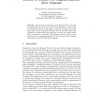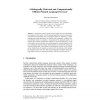254 search results - page 10 / 51 » How Talker Identity Relates to Language Processing |
ENTCS
2006
13 years 7 months ago
2006
We investigate the construction of linear operators representing the semantics of probabilistic programming languages expressed via probabilistic transition systems. Finite transi...
ER
2006
Springer
13 years 11 months ago
2006
Springer
One of the main drawbacks of the Semantic Web is the lack of semantically rich data, since most of the information is still stored in relational databases. In this paper, we presen...
BMCBI
2008
13 years 7 months ago
2008
Background: When term ambiguity and variability are very high, dictionary-based Named Entity Recognition (NER) is not an ideal solution even though large-scale terminological reso...
MICAI
2004
Springer
14 years 29 days ago
2004
Springer
Abstract. Conventional artificial neural network models lack many physiological properties of the neuron. Current learning algorithms are more concerned to computational performanc...
AC
2000
Springer
13 years 12 months ago
2000
Springer
In these notes, we give an overview of the join calculus, its semantics, and its equational theory. The join calculus is a language that models distributed and mobile programming. ...



